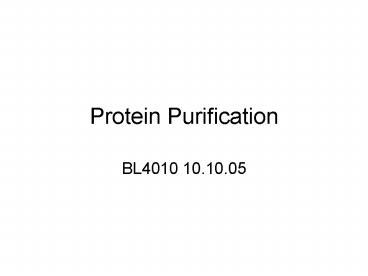Protein Purification - PowerPoint PPT Presentation
1 / 24
Title:
Protein Purification
Description:
'Prestained' markers have dyes covalently bound BEFORE ... Four contributing factors to enzyme catalysis. NO ONE MECHANISM ACCOUNTS FOR CATALYSIS ALONE! ... – PowerPoint PPT presentation
Number of Views:50
Avg rating:3.0/5.0
Title: Protein Purification
1
Protein Purification
- BL4010 10.10.05
2
The basic techniques
- Concentration (size)
- precipitation
- ultrafiltration
- dialysis
- centrifugation
- Chromatography (size/charge/chemistry)
- ion exchange
- size exclusion
- affinity
- hydrophobic interaction
- Electrophoresis (size/charge)
- "native"
- denaturing
- isoelectric focusing
- 2-dimensional
- Immunological
- chromatography
- in situ imaging
- immunoblotting
3
Electrophoresis (SDS-PAGE)
- Tris-glycine buffer
- 10 SDS
4
Electrophoresis
Prestained markers have dyes covalently bound
BEFORE electrophoresis - increased MW
5
Electrophoresis
- Protein detection using dyes
- Coomassie blue
- Sypro
- Cybergreen
- Silver staining
Staining with dyes AFTER electrophoresis - no
change in MW non-covalent interaction
6
Western blotting
- Separate proteins by electrophoresis
- Transfer to membrane (e.g. nitrocellulose)
- Bind primary antibody
- Bind secondary antibody
- Detection
7
Immuno-Affinity Chromatography
- antibody fixed to matrix
- protein binds to antibody
- wash unbound and loosely bound proteins off
column - elute protein with change in salt/pH
8
Hydrophobic interaction chromatography
- Hydrophobic group bound to solid phase
- Binding
- high salt (increases water surface tension,
decreases available water molecules, increases
hydrophobic interactions) - Elution
- decrease salt
- add detergent
- decrease polarity
- of mobile phase
9
Assay and Specific Activity
10
Criteria for purity
- When is protein pure or pure enough?
- homogeneity
- protein complexes?
- constant specific activity
- Practical further attempts at purification are
futile since the only material left in the
fraction is the material that actually is
responsible for the activity being assayed.
11
Protein purification simuation
- http//www.tlsu.leeds.ac.uk/courses/bioc2060/prote
inlab102/proteinlab.html
12
Enzymes
- BL4010 10.12.05
13
Objectives
- What is an enzyme?
- How do enzymes work?
- energetics
- underlying general mechanism
- components (prosthetic groups, coenzymes)
- specific mechanisms
- Ch.13.1, 13.2, 14.1, 14.2, 14.3, 14.4, 14.5
14
What is an enzyme?
- Macromolecular biological catalyst
- Can be protein or RNA
15
What is an enzyme?
- Macromolecular biological catalyst
- What is a catalyst?
- is not altered by reaction
- participates but emerges unchanged
- increases the rate at which substrates and
products reach equilibrium - does not alter equilibrium
16
Why enzymes?
- Why invest energy and resources into creating a
large catalyst? - Enzymes endow cells with the remarkable capacity
to exert kinetic control over thermodynamic
potentiality - Fine tune selectivity (substrate binding
specificity) - Fine tune catalytic rate
- Additional regulatory control (e.g. allostery,
signalling networks)
17
Enzymes are good catalysts
- Enzymes can accelerate reactions as much as 1016
over uncatalyzed rates! - Urease is a good example
- Catalyzed rate 3x104/sec
- Uncatalyzed rate 3x10 -10/sec
- Ratio is 1x1014 !
18
Enzymes are selective catalysts
- Enzymes selectively recognize proper substrates
over other molecules - Enzymes produce products in very high yields -
often much greater than 95 - Specificity is controlled by structure - the
unique fit of substrate with enzyme controls the
selectivity for substrate and the product yield
19
How do enzymes work?
- How do catalysts in general work?
20
The transition state
- Understand the difference between ?G and ?G
- The overall free energy change for a reaction is
related to the equilibrium constant - The free energy of activation for a reaction is
related to the rate constant - It is extremely important to appreciate this
distinction!
21
(No Transcript)
22
How do enzymes work?
- Enzymes accelerate reactions by lowering the free
energy of activation - HOW?
23
Four contributing factors to enzyme catalysisNO
ONE MECHANISM ACCOUNTS FOR CATALYSIS ALONE!
- Specific substrate binding
- local concentration of reactants
- productive orientation of reactants
- binding energy used to offset loss of entropy
- Control over solvent interactions
- desolvation (binding energy offsets)
- ordered solvent in binding pocket
- Induction of strain on reactants
- Alternate reactive pathway
- transient involvement of enzyme functional groups
24
How do enzymes work?
- Enzymes accelerate reactions by lowering the free
energy of activation - Enzymes do this by binding the transition state
of the reaction better than the substrate































